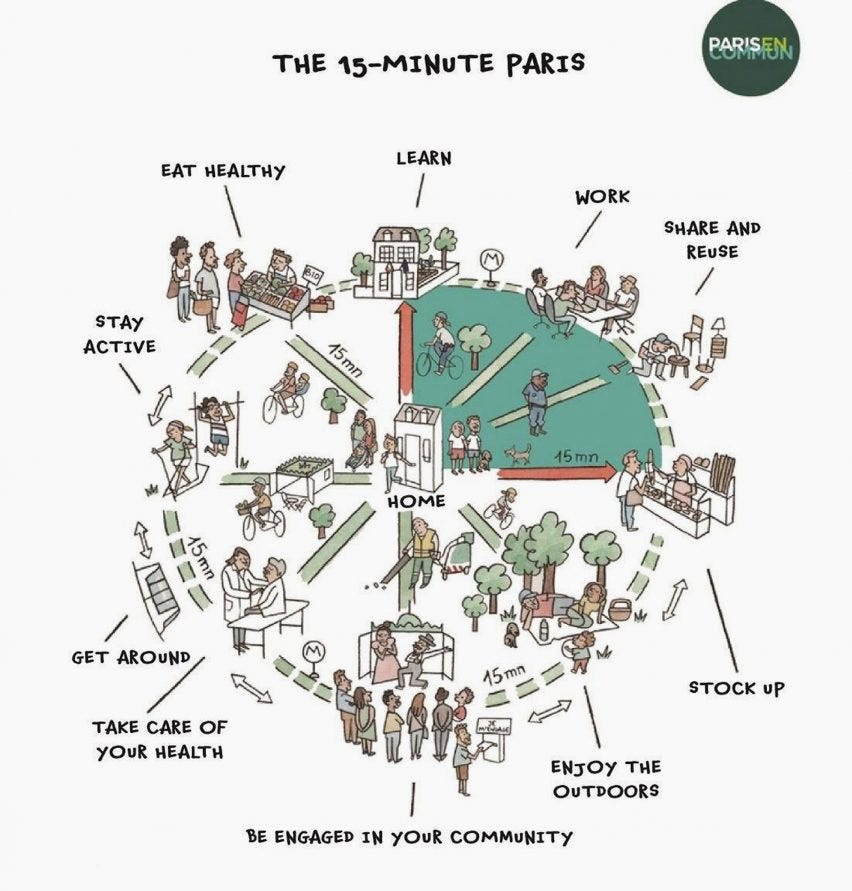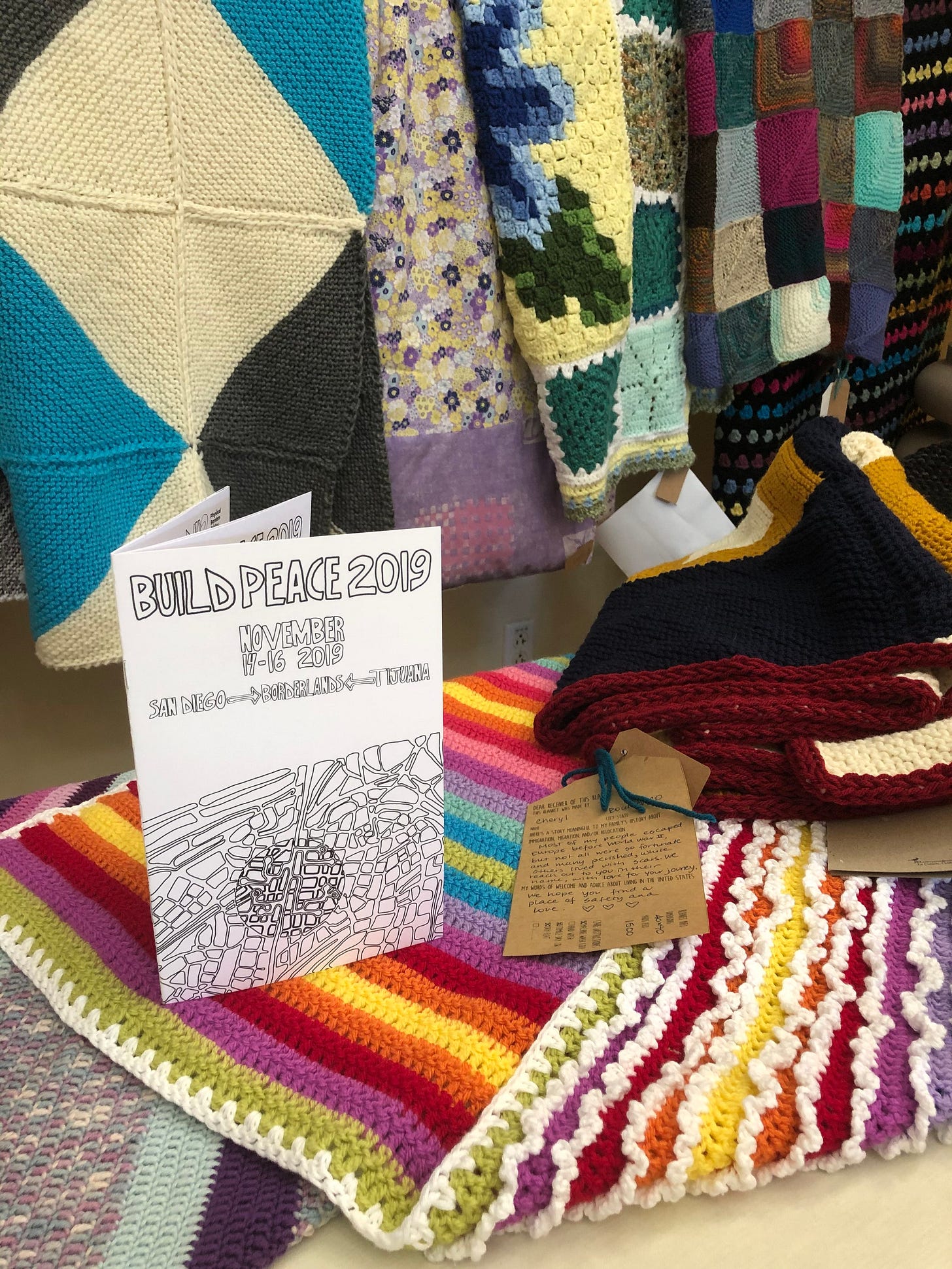Welcome to Just Two Things, which I try to publish daily, five days a week. Some links may also appear on my blog from time to time. Links to the main articles are in cross-heads as well as the story. Recent editions are archived and searchable on Wordpress.
1: The 15-minute city
Carlos Moreno is the Paris-based academic who first proposed the idea of the “15-minute city”, which Paris Mayor Anne Hidalgo has made a centrepiece of her urban strategy for the city. He’s interviewed in the latest issue of Resurgence magazine—it’s one of the articles the magazine has put online.
Here’s the description of the 15-minute city:
In such a city, all residents should be able to access their daily needs of home, work, education, care, essential shopping and socialising within the distance of a 15-minute walk or bike ride. A 15-minute city would feature elements such as widened pavements and expanded bike networks, while space once used for parking would be repurposed for more social interactions such as outdoor dining, or play areas for children.
One of the building blocks is that basic social services such as education and health need to operate in a way that makes them accessible within 15 minutes, so more importance is attached (for example) to effective local health centres.
(Drawing of the 15-minute city by Micael, via Dezeen. (C) Micael)
One of the things I like about the interview is his indignation about how the current city works, and how much time it wastes.
People living in cities have “accepted the unacceptable” for too long, says Sorbonne professor Carlos Moreno. Urban life involves large amounts of wasted time adapting to what he calls the “absurd organisation” of cities, which require a lot of travelling to get to and from basic functions such as home, work, education and social interaction.
And another thing I liked is how quickly his proposal for the 15-minute city has moved from the utopian to—at least—the edge of mainstream:
When Moreno proposed the concept six years ago at the UN climate talks in Paris, people considered it a great idea but too utopian, mainly because they thought it unrealistic that everyone should work close to home. Fast-forward to 2020, and the Covid-19 pandemic forced many people all over the world to work not just closer to home, but actually at home, using technology to access meetings and information they previously had to travel to a central place of work for.
In other words it’s another space where the pandemic has acted as an accelerator for ideas that were already floating around. One of the reasons it’s caught on is because rather than being a mechanism or a model, it’s a narrative about how urban life ought to be.
As well as Hidalgo’s initiative (Moreno is an adviser) the C40 urban cities network is now promoting the idea. Other cities are following Paris’ lead: Barcelona, Rome, Shengdu, and in Australia. At the end of last year, he won the Obel Award, an international prize for “outstanding contributions towards changing the physical, designed environment for the common good.” Moreno reports that he is “overwhelmed” by the amount of interest in the idea. Which is a problem, but better than the alternative.
One way for cities to develop the 15-minute city without having to rebuild their public realm is simply to use existing buildings more intensively:
“The model of urbanism was orientated to use a building for only one activity. As a result, buildings are closed for 60–70% of the time. We want to propose new functions for existing buildings, for different activities,” he says. For example, Paris now has schoolyards open at the weekend to expand the number of play areas. It also closes streets around schools to vehicles to make it safer for children to walk or cycle, and to reduce their exposure to air pollution.
As always with cities, there’s a risk that those that become “15 minute areas” then get gentrified, leaving poorer citizens struggling with longer journeys and poorer local services. Moreno is clear that it’s important to build the 15-minute city everywhere, regardless of local income levels or urban status.
(L)ocal shops and commerce such as bakeries and handicrafts can be encouraged in poorer neighbourhoods by charging below-market rents... To develop the common good, new financial tools will be needed, he believes. One example of this is the participatory budget. This can support the creation of 15-minute cities by allowing citizens to propose projects and vote on which go ahead and how much municipal spending is allocated to them.
The Obel Award comes with a $100,000 prize, and Moreno plans to use this to move on to a related idea—the 30 minute territory, for lower densities.
This focuses on ideas for areas that are less dense than big cities, where it may not be possible for people to access all essential urban functions by foot or by bike. “We need to keep the concept of the 15-minute city but imagine new ways to implement its principle of proximity in other densities,” he explains. Moreno’s team has already started a new experiment in southern France to understand behaviours at this lower level of density.
2: Blankets for humanity
The Welcome Blanket is a American project that uses craft to transform abstract ideas about migration into participatory artistic action. There seems to be very little written about it beyond its website, but the website is captivating:
We ask you to use your head, heart, hands, and histories to craft the country we wish to see. Woven into the fabric of our country is a fundamental idea: our diversity, our multiple perspectives, and our personal stories make the United States great.
Anyone is invited to make a Welcome Blanket, and add to it a note of welcome. After being displayed and catalogued, the blankets are given to families who are newly arriving in the US by one of the project’s refugee resettlement partners.
(Photo: welcomeblanket.org)
These are the first part of the instructions for makers:
Make a Welcome Blanket. The design guidelines are 40” X 40”, easy to care for, and it should hurt a little to give away.
The project was created by the artist Jayna Zweiman, and originally it was intended as a riposte to Trump’s plans for a 2,000 mile wall—she wanted to knit blankets that represented 2,000 miles of yarn. They achieved that objective quite quickly (it represented 6,000 blankets) and now have a goal to circle the world with yarn instead. I suppose that might be called a stretch target.
As Zweiman writes:
Through this project, we have developed an international network of people sharing stories and symbols of warmth. The act of hand making (knitting, sewing, quilting,crocheting, weaving, felting, etc.,) a blanket and then writing down our individual immigration/migration/relocation stories shift the paradigm of our newest waves of “refugees” from “others” to “one of us.”
There’s a fantastic display of Welcome Blankets here.
Ukraine notes.
The war in the Ukraine is bringing out the best in digital activists. Motherboard has a story about how people are identifying propaganda and Russian fake news more or less in real time.
On February 21, Tass—a Russian news agency—reported that five Ukrainian soldiers had crossed the border into Russia riding two armored personnel carriers (APC). ... Soon after the footage hit the internet, sleuths had picked it apart. One Twitter user used metadata of the video file and satellite imagery to geolocate the images and figured out it had all been filmed in the exact same location where Russia previously claimed a shell had destroyed a border post.
My thanks to Charles Arthur’s Overspill newsletter for the link.
j2t#272
If you are enjoying Just Two Things, please do send it on to a friend or colleague.




